Japan
Wood Products Prices
Dollar Exchange Rates of 25th
October
2018
Japan Yen 111.88
Reports From Japan
¡¡
Little risk of recession when
consumption tax goes up
next year
The Japanese government has confirmed its intention to
raise the consumption tax to 10% from the current 8% in
October 2019 as planned. The rationale for the increase is
to address the rapidly rising social security costs as the
population ages.
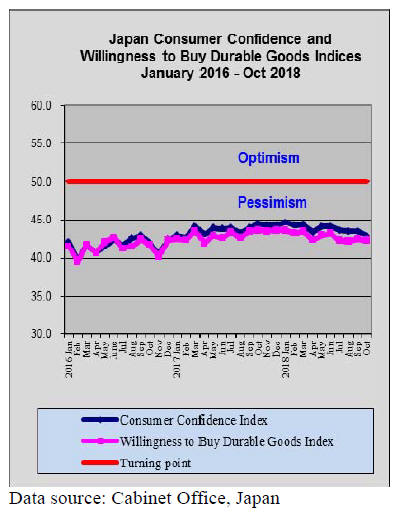
While GDP numbers look healthy, GDP for the
April-June
period increased at an annualised rate of 3%, reversing a
slight decline in the earlier quarter, consumer spending
continues to be weak.
However, the government has concluded the risks to
private consumption from this 2% rise in consumption tax
should not seriously dampen consumption for long.
The government argues that the impact on consumption
will be small as tax on food and drinks will not be raised.
Exports to China and US slip
Ministry of Finance data show that, for the first time since
2016, month on month exports fell in September.
Shipments to the US dropped due to falling exports of
construction and mining machinery, auto parts and
medicines. Also car exports were down around 7% year on
year.
The US administration is pressuring Japan to address its
almost US$70 billion trade surplus with the United States,
much of which stems from car exports.
Analysts report Chinese businesses are delaying new
investment fearing the US/China trade frictions will
further impact export opportunities. This cut-back by
Chinese companies has resulted in falling machinery
orders placed with Japanese companies who report orders
have been falling for around six months.
Strong dollar helps keep yen/dollar exchange rate in
check
The US dollar continues to strengthen and towards the end
of October was at an 11 month high against the Japanese
yen which touched 114 to the dollar at one point. A weak
yen boosts the profits made abroad when they are
repatriated by Japanese companies.
There are concerns over the pressure being exerted on
Japan to reduce its trade surplus with the US but for now
no drastic action is expected from the US side. Speaking to
the media recently the Japanese prime minister said he and
the US President had agreed to continue talks to resolve
the surplus issues.
However, recent losses first in Wall Street and then in
Europe and Asia caused the yen to rise against the dollar
because investors sought a ¡®safe-haven¡¯. This tipped the
yen back to its more recent level of 112 to the dollar.
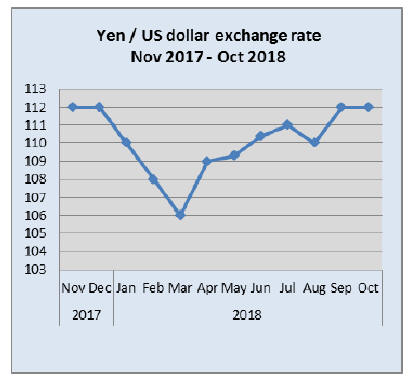
September Housing starts
September housing starts came in at the same level as in
August but were down year on year by around 2%. On the
basis of the first nine months housing data, annual starts
for 2018 will be in the region of 945,000.
The domestic housing market in Japan is shrinking fast
due to the declining population. The number of new
homes built in fiscal 2017 dropped to 950,000 from a peak
of 1.29 million in fiscal 2006. Analysts estimate that by
2030 annual housing starts will only be around 550,000.
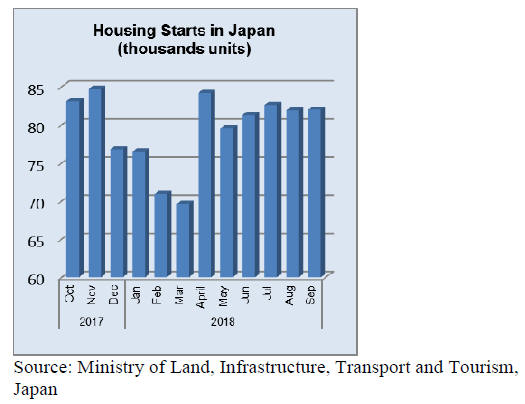
Import round up
Doors
August door imports
Japan¡¯s August wooden door (HS441820) imports
continued the decline that began in June after the peak in
May imports.
Year on year, August 2018 wooden door imports were
unchanged from a year earlier down slightly and were just
slightly down from levels in July.
Over 90% of August wooden door imports were from 4
sources, China (61%) followed by the Philippines (20%),
Indonesia (7%) and Malaysia (8%). In July there was a
shipment of wooden doors from Sweden worth around 7%
of total monthly import values.
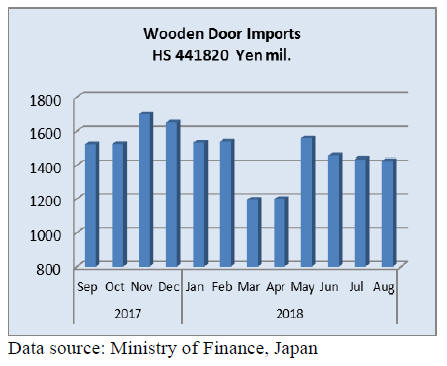
Window imports
August window imports
After a peak in March this year Japan¡¯s imports of wooden
windows (HS441810) declined for the following 6
months. Year on year, August imports of wooden
windows were down 16% and compared to the previous
month there was a 4% drop.
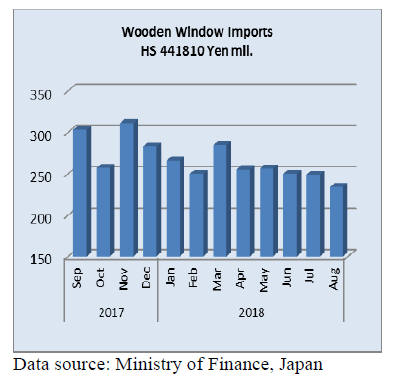
In August three suppliers accounted for 85% of the
value
of Japan¡¯s wooden window (HS441810) imports namely
China (38%), the Philippines (24%), the US (23%) and
Sweden (8%).
Assembled flooring
August flooring imports
Import values for wooden flooring entering Japan in
August confirm that HS441875 is the main product
followed by HS441879.
In August, as in the previous month these two categories
of assembled flooring accounted for around 90% of the
value of all assembled wooden flooring imports. The top
three shippers of HS441875 in August were China (43%),
Indonesia (23%) and Malaysia (15%).
In contrast, for HS441879 the main shippers in August
were Indonesia (50%) and Vietnam (17%).

Plywood
August plywood imports
After two consecutive months of decline there was an uptick
in the volume of plywood imports with both of the
two major suppliers Malaysia and Indonesia posting
month on month gains.
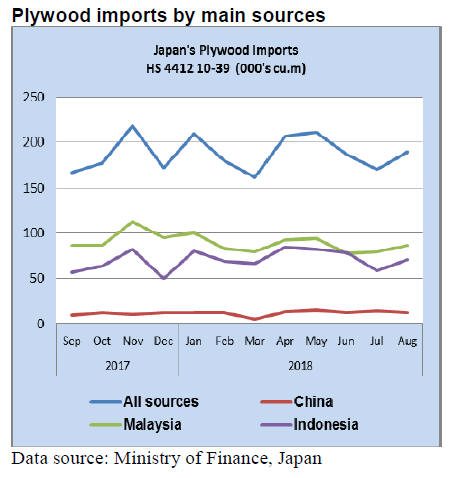
August imports of plywood (HS441210-39) were flat
year
on year but there was a significant year on year decline in
the volume of imports from Malaysia with some of the
slack being taken up by shipments from Indonesia which
jumped around 8% in August compared to August 2017.
Plywood imports from China still fall within a narrow
range which has been fairly consistent for the year to
August.
Imports of HS441231 dominte Japan¡¯s plywood imports
accounting for over 89% of imports in August with
Malaysia and Indonesia being the main shippers. In
August shippers in Vietnam built on the gains recorded
with the July plywood shipments.
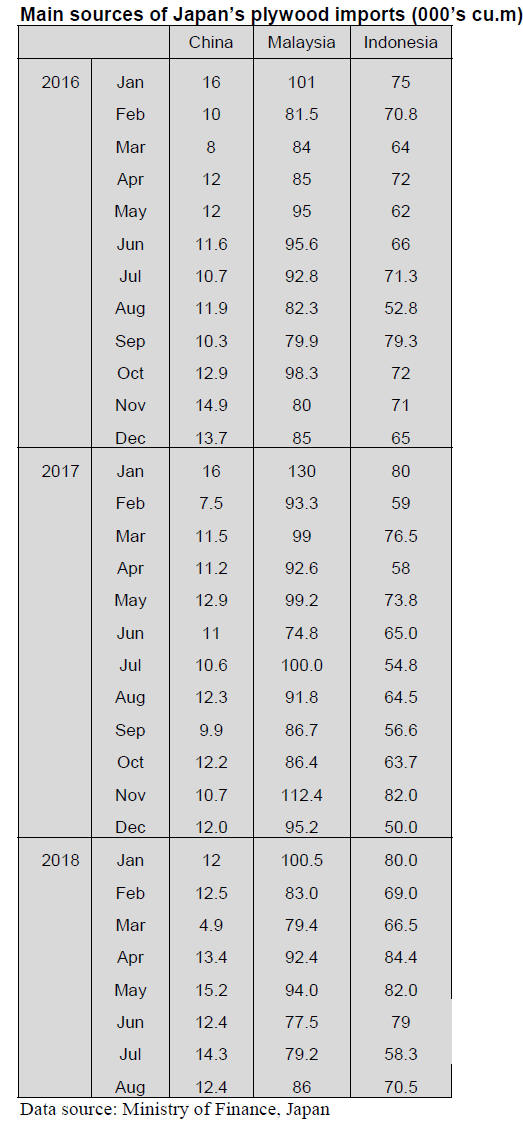
Trade news from the Japan Lumber Reports (JLR)
For the JLR report please see:
http://www.nmokuzai.
com/modules/general/index.php?id=7
Influence of U.S.-China trade war
What kind of influence on-going U.S.-China trade war
would give to wood industry is everybody¡¯s concern.
On September 24, U.S. decided to impose 10% sanctions
duty on Chinese wood products while China announced to
impose 5% or 10% retaliatory tariff on imported wood
products from the U.S. However, duties China imposed
initially of 20-25% are reduced to 10% except for
Southern pine logs. China obviously tries to solve the
issues by the end of this year.
In 2017, import of wood products by China from the U.S.
was 6,096,000 cbms of logs, 15% more than 2016 and
3,205,000 cbms, of lumber, 9.8% more. About one third of
the imports on both logs and lumber is estimated Southern
pine so 25% duty on logs would give serious impact on
log import.
Duty on lumber is 10% (initially 20%) but it is hard to see
what kind of impact hot North American lumber market
would give to supply and prices to China. Soaring North
American lumber market is negative factor to the trade
with China but the fact is that softwood log export to
China in 2017 was 7.2% more than 2016 and softwood
lumber was 21.2% more.
Through July this year, softwood log import was 15.3%
more and softwood lumber was 39.4% more so growth
continued. Although grade and prices of export are
different from U.S. domestic products, there must be some
connection between the two. Weighted average prices of
15 structural lumber dropped by US$159, 27.4% in
September from the peak in June so even with 10% duty,
the prices are lower than the peak time.
On softwood logs, duty on hemlock is 5%. If China shifts
to Canada to buy hemlock logs, it would influence supply
of logs and lumber for Japan. Duty on Alaskan logs is
10%. If China slows down purchase of Alaskan logs,
Japan will have more chance to buy but if low grade logs
China buys lose sales outlet, log harvest itself would be
reduced.
Trade of wood products by both countries is about US$3.1
billion. If the war is over within this year, there is very
little impact to Japan but if the war prolongs, various
impacts should give to worldwide wood trade since two
countries are major supplying and consuming countries.
Plywood
Plywood market is stagnating. September sales were slow
and there is no fall demand surge. Imported plywood
market is firm as the importers try to increase the sales
prices by increasing suppliers¡¯ prices.
Market prices of softwood plywood are holding steady
despite spotty low prices in distribution channel.
Domestic manufacturers hold the sales prices firmly,
which stops slide of the market prices.
Softwood plywood production in August was 252,000
cbms, 1.1% less than August last year and 5.9% less than
in July because working days in August were shorter due
to vacation season. In this structural plywood production
was 232,800 cbms, 3.4% less and 6.3% less. Nonstructural
plywood production was 19,200 cbms, 39.2%
more and 0.9% less.
The shipment of softwood plywood in August was
240,800 cbms, 3.7% less and 7.2% less. That of structural
plywood was 221,800 cbms, 6.5% less and 7.6%v less.
That of non-structural plywood was 18,900 cbms, 49.3%
more and 1.5% less.
The inventory of structural plywood was 157,000 cbms,
increase of 10,900 cbms. With increasing inventory, some
dealers asked price reduction but the manufacturers say
that the inventory is still less than one month shipment and
with increasing demand for non-structural plywood, the
manufacturers do not listen to price reduction request
.Users are now getting cautious in buying with rumors of
lower prices in the market.
On imported plywood, the suppliers intend to increase the
sales prices before rainy season with prospect of lower log
supply and higher log prices and offer volume is less than
before.
Dealers in Japan need to increase the market prices as
higher cost cargoes will keep arriving so the market prices
of imported plywood are climbing. However, there were
some low price offers in September as the dealers made
aggressive sales in September before midterm book
closing at the end of September so price hike was limited.
The prices of imported plywood will be firm in October
and be climbing in coming months.
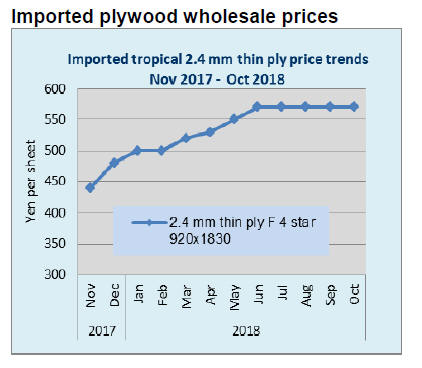 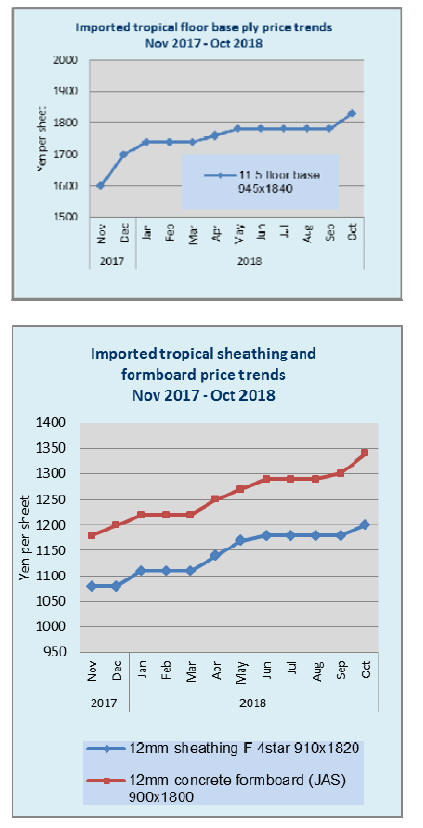
Sing Yang of Malaysia acquired forest
management
certificate
Sing Yang group, the largest plywood manufacturer in
Sarawak, Malaysia has acquired forest management
certificate on natural forest. This is the second forest
district Sing Yang received the certificate.
The forest is about 72,685 hectares, where acacia is main
species, which is used for manufacturing plywood. It
acquired three years certificate of MTCS (Malaysian
Timber Certificate System), which means the area is
admitted as sustained yield forest. MTCS is tied with
PEFC.
|